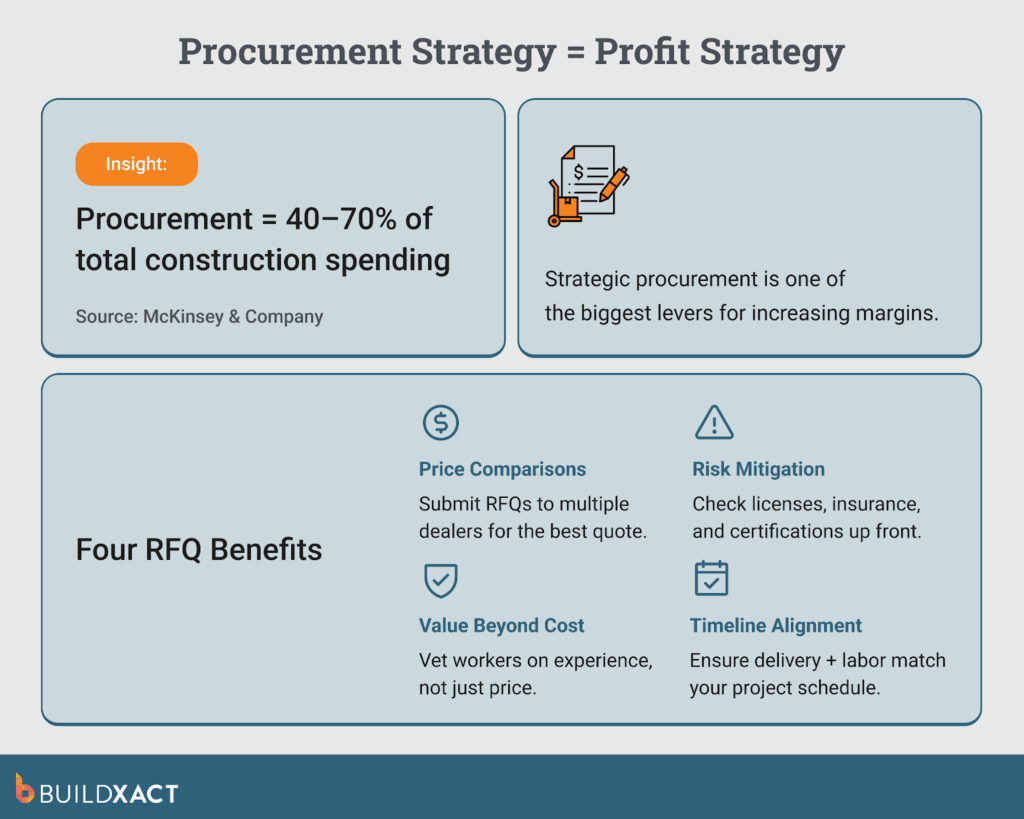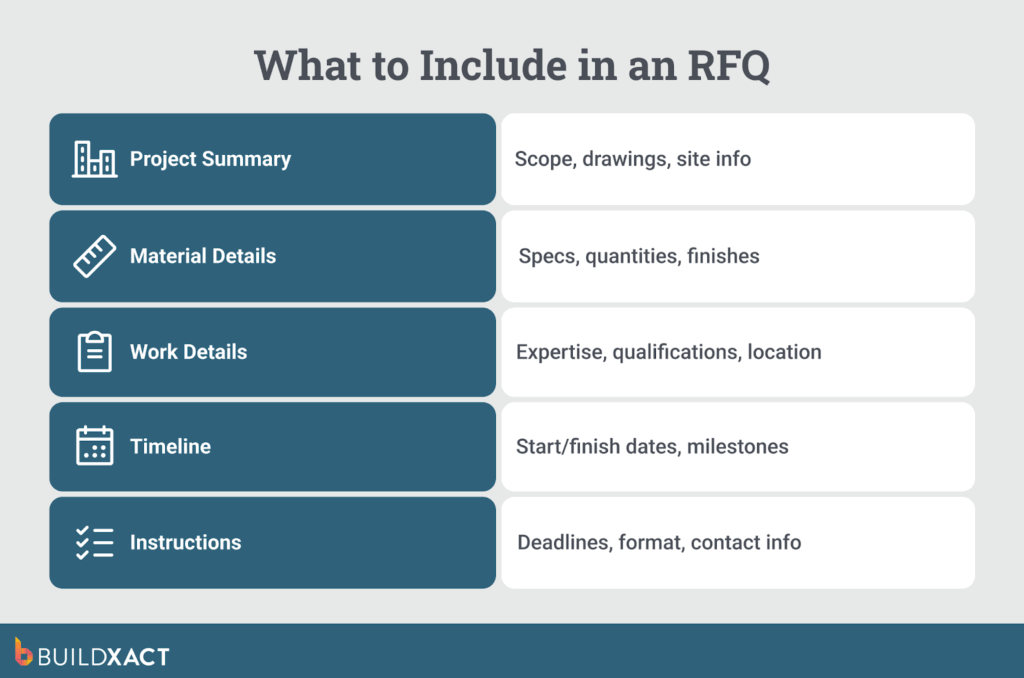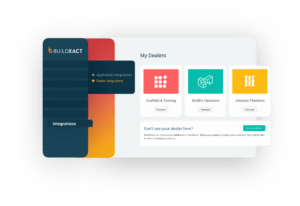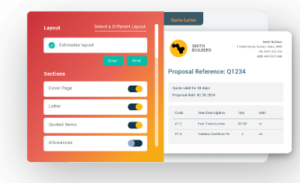In residential construction, even a simple job can stall when quotes don’t line up. You spend hours chasing dealers, sorting through inconsistent bids, and trying to make fair comparisons — all before the real work even begins.
When every vendor uses a different format or leaves out key details, accurate budgeting is replaced with uncertainty and error-prone guesswork.
That’s where an effective Request for Quote (RFQ) process makes all the difference. Whether you’re sourcing materials or equipment, or subcontracting part of the project, a clear RFQ will help you quickly compare prices and choose partners you can rely on.
In this article, we’ll explore what makes a strong RFQ in construction, the best way to structure one for reliable responses, and how intelligent estimating software can transform time-consuming RFQ admin into a fast, streamlined process.
What Is a Request for Quote (RFQ)?
A “request for quote,” or an RFQ, is a formal document compiling pricing, availability, and other key details from dealers or subcontractors for specific goods or services. The purpose of an RFQ is to standardize how businesses compare costs before they make a purchase or award work.
An RFQ in construction helps builders streamline bidding and ensure every quote is based on the same scope of work. But they’re also used widely across other sectors and industries, each with its own purpose:
- Home builders: To source materials or subcontractor quotes for specific trades
- Commercial developers: To compare bids for clearly defined work packages
- Government agencies: To procure public works or maintenance services
- Federal departments: To purchase goods or small-scale construction projects
- Housing authorities: To source materials for affordable housing developments
Across these scenarios, the goal of an RFQ is the same: to create transparency and consistency in pricing. Standardized quotes allow decision-makers to evaluate offers based on cost, quality, and timing, so that every project is based on solid financials.
RFQs vs RFPs
While they may sound similar, it’s important not to confuse RFQs with RFPs (Requests for Proposals). Both are essential procurement methods, but they serve different purposes and occur at various points in the project lifecycle.

An RFQ is used when the scope of work is already defined and you want to gather comparable pricing from dealers or subcontractors. RFQs are best for straightforward, repeatable purchases with clear specifications, quantities, and deliverables.
Example: A builder might issue an RFQ to request material prices from dealers or to collect bids from electricians and painters after the design has been finalized. Because everything is already decided, including the materials and work methods, the decision comes down to factors like cost and timing.
An RFP is broader and focuses on strategy and technical expertise rather than just price. It’s typically used earlier in the planning phase, when a project’s goals are defined but the approach is not.
Example: A developer might issue an RFP when seeking a full design-build contractor for a new facility or when evaluating alternative construction methods that could improve energy efficiency or shorten timelines.
In short:
- Choose an RFQ when you need competitive prices for well-defined work.
- Choose an RFP when you need expert input to shape the project’s direction or find the best solution.
Often, an RFP will lead to multiple RFQs later in the process. This happens after the design is set, when it’s time to secure the most cost-effective quotes.
Why Do RFQs Matter?
As with any kind of purchasing, it’s essential to shop around for the best value — especially in today’s climate of volatile material costs and ongoing skilled labor shortages.
RFQs help you manage this process, by creating a structured way to compare dealers and subcontractors — not just on cost, but on timelines, compliance, qualifications, and more. With procurement often making up 40–70% of a construction company’s total spending, getting it right is crucial.
“[C]ompanies that treat procurement as a strategic capability — not just an admin task — can see margins improve by 5 to 10 percentage points over their peers.”
— The strategic era of procurement in construction, McKinsey & Company
Here’s how RFQs help you move in that direction:
- Price comparisons: Submit RFQs to multiple dealers to get competitive quotes on materials and labor.
- Risk mitigation: Ensure vendors have the proper licenses, insurance, and safety certifications before awarding work.
- Value beyond cost: Vet workers by qualifications and track record to ensure project quality, not just affordability.
- Timeline management: Use RFQs to align delivery schedules and labor availability with project milestones.

It’s no surprise that a growing number of builders are using construction estimating software to streamline the RFQ process. The right platform helps you create accurate quotes faster, submit RFQs at scale, and compare responses side by side, so you can make the best call for your bottom line and your build.
What to Include in an RFQ: 5 Key Elements
An RFQ that’s clear, complete, and easy to respond to will be more likely to attract detailed, accurate quotes from dealers and subcontractors.
Here’s what to cover in your RFQ to make it as simple as possible for bidders to provide you with all the information you need.

#1: Project summary
Start with a concise overview of the job, outlining the project type, size, and objective. This helps dealers and subcontractors understand the overall scope before diving into details. Include key information like:
- Site address and contact information
- Relevant plans, blueprints, or takeoffs
- Project milestones or delivery stages
The more context you provide about the project, the more accurate and comparable your quotes will be.
#2: Material details
If your RFQ involves materials, you need to get specific. List item names, dimensions, and quantities directly from your takeoff, and define elements such as product quality, brand preferences, and even finish details like color or texture.
For example, rather than referencing “timber siding”, a detailed RFQ would specify “premium-grade cedar cladding, 140mm boards”. Clear details like this eliminate uncertainty and ensure you’re comparing like-for-like costs.
#3: Work details
When requesting labor, your RFQ should outline the type of work needed, as well as any qualification, safety, or licensing requirements. For subcontractor RFQs, include:
- Site access details and working conditions
- Delivery or setup expectations
- Budget range, if applicable
Being upfront about expectations and constraints helps bidders quote accurately and plan resources effectively.
#4: Timeline
Outline when materials or services are needed onsite and how this aligns with your build schedule. Include start and completion dates, plus any time-sensitive phases like framing or roofing.
Adding payment milestones or progress draw schedules will help bidders understand cash flow expectations. A detailed timeline minimizes delays and keeps projects moving smoothly.
#5: Submission instructions
End your RFQ with clear submission requirements, specifying:
- The quote deadline
- How and where to send proposals
- Required formats or supporting documentation
- Evaluation criteria (e.g., price, experience, compliance)
When bidders know exactly what to provide and how you’ll assess the information, you’ll receive higher-quality responses that allow you to make faster, more strategic purchasing decisions.
How to Create an RFQ: A Step-By-Step Breakdown
Now that you know what to include in your RFQ, the next step is to put it all together in a structured format and share it with the appropriate parties, so you can gather responses.
Step 1 — Define your scope and prepare details
Begin by confirming exactly which items need pricing (materials, labor, etc.). Make sure everyone quoting has access to the same project information for accuracy and consistency.
Include information such as:
- Finalized plans, drawings, and measurements
- Delivery requirements and compliance details
- Clear specifications for materials or workmanship
Incomplete details often lead to inaccurate quotes and scope gaps that create problems later. Tools like Buildxact’s digital estimates and takeoffs make it easier to generate precise quantities and line items, ensuring your RFQ data stays consistent across bidders.
Step 2 — Send clear, complete RFQs to the right contacts
Next, share your RFQ with a small, focused group of qualified dealers or subcontractors. Usually, around three to five is enough to ensure healthy competition.
Be sure to outline:
- Submission deadlines and instructions
- Preferred file formats or templates
- Contact details for questions or clarifications
Centralized communication avoids common issues like misplaced updates or missed deadlines, which can slow down bidding.
For example, Buildxact lets you send multiple RFQs at once, attach plans, and track vendor responses in one dashboard. As a result, scattered communication is replaced with a clear communication trail that prevents lost emails or forgotten follow-ups.
Step 3 — Compare, evaluate, and finalize your selection
Once responses arrive, review them carefully for the following:
- Completeness of pricing and scope
- Unit costs, exclusions, and lead times
- Evidence of insurance, licensing, or compliance
While it’s true that an RFQ is focused purely on cost, as a builder or GC sending out an RFQ, your decision is likely to weigh additional factors like availability and reputation.
That’s why it’s wise to adopt intelligent estimating tools, like AI-powered estimating assistants, that enable you to compare bids automatically, spot cost variances, and convert the winning quote into a purchase order.
Not only does this simplify and speed up the bidding process, but it also creates a baseline level of professionalism and consistency once work gets going. And if you’re able to deliver consistently quality workmanship sustainably, it can make all the difference for repeat business, word-of-mouth marketing, and referrals.
What to Expect in a Response to RFQ
Once you’ve issued your RFQ, you’ll be looking for responses that are thorough, timely, and competitive. For busy builders and contractors, these details can make the difference between a smooth project start and costly confusion down the line.
A professional RFQ response should include the following:

Expertise and qualifications
Every bidder should demonstrate that they have the skills and experience to complete the job safely and to standard. Look for:
- Relevant trade licenses, insurance, or certifications
- References or examples of similar projects
- Any specialist capabilities that set them apart
Strong qualifications not only confirm capability but also reduce risk when you’re managing multiple subcontractors or dealers.
Costs and pricing breakdown
Responses should provide transparent pricing with unit costs, line items, and totals for materials or labor. Check for:
- Clear descriptions of each priced item
- Taxes, surcharges, or delivery costs
- Notes on any exclusions or optional add-ons
A consistent cost format across all quotes makes comparison faster and helps prevent hidden expenses later in the build.
Availability and scheduling
Dealers and subcontractors should confirm that they can meet the timelines outlined in your RFQ. Look for firm delivery or start dates and any constraints that might affect project milestones. Reliable partners will clearly outline how they plan to stay on schedule.
Additional fees and payment terms
Each response should disclose any potential extra charges, such as equipment rentals, permits, or disposal fees. Review payment structures, warranties, and guarantees to confirm they align with your project’s cash flow and risk tolerance.
Project understanding
A thorough response demonstrates clear comprehension of the project’s scope. The bidder should summarize what’s required, reference materials or plans, and demonstrate how they’ll deliver to spec. This signals commitment and attention to detail — both crucial for a successful construction project.
Compliance and documentation
Every RFQ response should include supporting documentation that proves compliance with industry and site standards. Expect to see:
- Trade or business licenses
- Safety and insurance certificates
- Acknowledgment that all RFQ instructions were followed
Complete documentation builds confidence that the bidder is professional, organized, and capable of getting the job done.
Equipped with detailed and consistent RFQ responses, you’ll have the insights you need to choose the right partners and deliver the best outcomes on every project.
What Do You Need for an RFQ in Construction?
An effective construction RFQ gives bidders the information required to quote accurately and avoid costly assumptions. Here’s what you’ll need to provide:
- Drawings or plans: Attach blueprints or digital takeoffs that clearly show the project scope.
- Material quantities and specs: List exact quantities, grades, and finishes to keep every bid consistent.
- Labor requirements: Outline trade skills, certifications, and site safety standards needed to complete the work.
- Site details: Note access limits, delivery points, parking restrictions, and working hours.
- Timeline: Specify delivery or installation deadlines aligned with your build schedule.
- Compliance: Request proof of insurance, licenses, and building code adherence to verify contractor qualifications.
A complete RFQ helps create a smoother bidding process that lets you move into the next stage of your project with confidence.
Frequently Asked Questions
What does RFQ mean in construction?
An RFQ (Request for Quote) is a formal document builders use to gather pricing for defined materials or services. It standardizes how dealers and subcontractors submit costs, helping you compare bids accurately and choose the best value option for your residential construction project.
How is an RFQ different from an RFP or an RFI?
An RFQ focuses on pricing for well-defined work. An RFP (Request for Proposal) seeks broader solutions and expertise, while an RFI (Request for Information) gathers background details before either process. RFQs come later (after plans and specs are set) to secure accurate, comparable quotes.
What should be included in a home construction RFQ?
A clear RFQ in construction includes project plans, material quantities and specifications, labor requirements, timelines, and compliance details like insurance and licenses. Including this information ensures bidders can quote accurately, helping you avoid inconsistencies and scope gaps across dealer and subcontractor responses.
What are common mistakes to avoid when creating an RFQ?
Avoid vague specifications, missing drawings, and unclear deadlines. Leaving out details like quantities or delivery dates can lead to inaccurate pricing and delays. Ensure every bidder receives the same information so quotes are consistent, complete, and directly comparable.
How do I evaluate RFQ responses fairly?
Review all quotes using the same criteria: price, scope completeness, experience, and compliance. Compare unit costs and check for exclusions or hidden fees. Consistent evaluation helps you identify true value, not just the lowest number, and select reliable partners.
Can I use one RFQ to source both labor and materials?
Yes. Many builders combine labor and material requests in one RFQ when scopes are linked (for example, framing labor and timber supply). Just make sure to separate pricing sections clearly so bidders can respond to each component accurately.
Final Steps for an Effective RFQ Process
Once you’ve reviewed your RFQ responses and chosen your preferred dealer or subcontractor, make sure you save all the relevant documentation and communications in a secure digital location, so you have everything on hand when you need it. Work the accepted RFQ results into your wider project estimate and ensure your final bid reflects the agreed terms and pricing.
Send More Accurate RFQs in a Fraction of the Time
Clear, consistent RFQs are the foundation of every successful build. When you can compare quotes quickly and easily, you can keep projects on schedule, maintain predictable costs, and meet client expectations.
With Buildxact’s intelligent estimating software, you can streamline the entire RFQ process, creating professional, accurate documents in minutes. Plus, residential-focused tools like AI-powered takeoffs, live dealer pricing, and centralized communication help you cut admin time, reduce errors, and win more of the right work. Book a demo or sign up for a 14-day free trial today.














